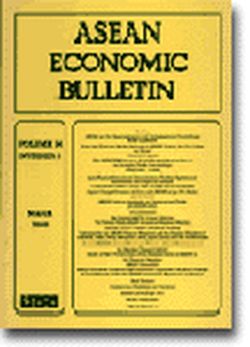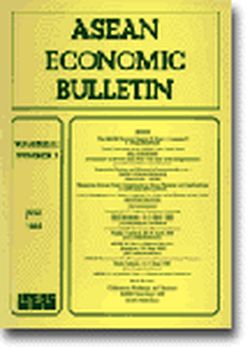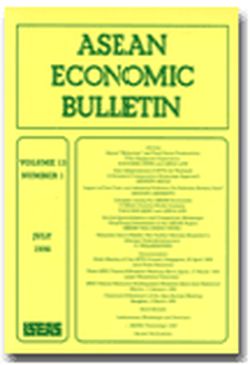ASEAN Economic Bulletin Vol. 14/1 (Jul 97)

Date of publication:
July 1997
Publisher:
Institute of Southeast Asian Studies
Number of pages:
120
Code:
AE14/1
Contents
-
Preliminary pages
-
Measuring and Comparing Progress in APEC, by Peter A Petri, contributor see abstractThe challenge APEC now faces is to create a dynamic process for continued progress. In recent months, the term âcomparabilityâ has become a code word among APEC officials for some tactical aspects of progress on APECâs liberalization agenda. This article explores ways of operationalizing the aggregate comparability and detailed comparability concepts in order to encourage productive co-operation in APEC. We argue that the advantages of APECâs ârepeated gameâ structure can be exploited by defining the contributions APEC expects from its members and by recognizing (positively or if necessary negatively) the efforts of individual economies. One conclusion is that a well-designed loop of information collection, dissemination and feedback could be helpful in stimulating substantive progress.
-
The Sustainability of East Asian Growth, by Karen Eggleston, contributor see abstractThis article aims to assess the factors responsible for high economic growth in Pacific Asia and the sustainability of that growth. Despite differences in data and methodology, recent empirical work by and large does convincingly demonstrate that productivity growth has not been the primary force behind East Asian growth. Sustaining the economic dynamism brought about by outward-looking, âmarket-friendlyâ policies will require continued and enhanced cultivation of human resources, social and economic infrastructure investment, and transition to productivity-based growth.
-
Policy Conflicts in Indonesia: The Impact of the Current Account Deficit Target on Growth, Equity and Stability see abstractIndonesiaâs target ceiling for the current account deficit (CAD) of 2 per cent of GDP conflicts with its target ceiling of 5 per cent per annum for inflation, because seeking to lower the CAD by depreciation in the face of balance of payments surpluses is inevitably inflationary. Moreover, limiting the CAD necessarily involves limiting capital inflow, so this policy also conflicts with the objectives of more rapid growth and accelerated poverty reduction which capital inflow makes possible. There is a perception that if a âlargeâ CAD is sustained, foreign debt will spiral out of control, squashing the economy under the burden of debt service. In fact, a stable ratio of the CAD to GDP results in stable ratios of debt and debt service to GDP. Moreover, movement towards these steady state ratios is slow, and easily accommodated in the process of structural change of the economy.
-
Workforce Productivity Enhancement and Technological Upgrading in Singapore see abstractIn three decades, Singapore has developed from a low-cost economic base to a relatively high-cost location where workforce productivity enhancement is the key to sustaining its competitive edge. This article examines the importance of educational upgrading and workforce quality to the future of the Singapore economy through skill training, retraining and ability to adjust to meet new demands of unpredictable changing global circumstances. A number of strategies have been implemented to transform Singapore into a headquarters of multinationals while pursuing a regionalization drive in the Asia-Pacific region. By the turn of next century, high technology usage, in particular information technology, is expected to be a way of life in offices, schools, and businesses.
-
Exchange Rate Policy and Market Power: A General Equilibrium Analysis for Singapore see abstractA computable general equilibrium (CGE) model of the Singapore economy is simulated to project the impact of the appreciation of the Singapore dollar under different export demand elasticity scenarios. The macroeconomic and sectoral results are not very sensitive to variations in the export demand elasticities over the elastic range. A significant change in the projections is apparent when highly inelastic export demand curves are adopted. These results are consistent with the economic performance of Singapore over recent years under the strong currency regime. The analysis thus supports the belief that Singapore is coming to enjoy some degree of market power in the world trade of manufactures.
-
DOCUMENTATION: Twelfth ASEAN-EU Ministerial Meeting, Singapore, 13-14 February 1997, Joint DeclarationTwelfth ASEAN-EU Ministerial Meeting, Singapore, 13–14 February 1997, Joint Declaration
-
DOCUMENTATION: The First Meeting of the ASEAN-China, Joint Cooperation Committee, Beijing, 26-28 February 1997, Joint Press Release
-
DOCUMENTATION: The Second ASEAN Transport Ministers (ATM) Meeting, Chiang Mai, Thailand, 28 February 1997, Joint Press Statement
-
DOCUMENTATION: First ASEAN Finance Ministers Meeting, Phuket, Thailand, 1 March 1997, Joint Press Communique
-
DOCUMENTATION: Eleventh Meeting of the Canada-ASEAN Joint Cooperation Committee, Montreal, Quebec, Canada, 6-7 May 1997, Joint Press Release
-
DOCUMENTATION: Round Table Assesses Implications of AFTA on Intellectual Property, Media Release
-
DOCUMENTATION: Third Meeting of the ASEAN-Republic of Korea Dialogue, Manila, 15–16 May 1997, Joint Press Statement
-
BOOK REVIEW: Managing Capital Flows in East Asia (Development in Practice), by Xavier Furtado, contributor
-
Conferences, Workshops and Seminars; ASEAN Chronology 1997; Recent Publications






